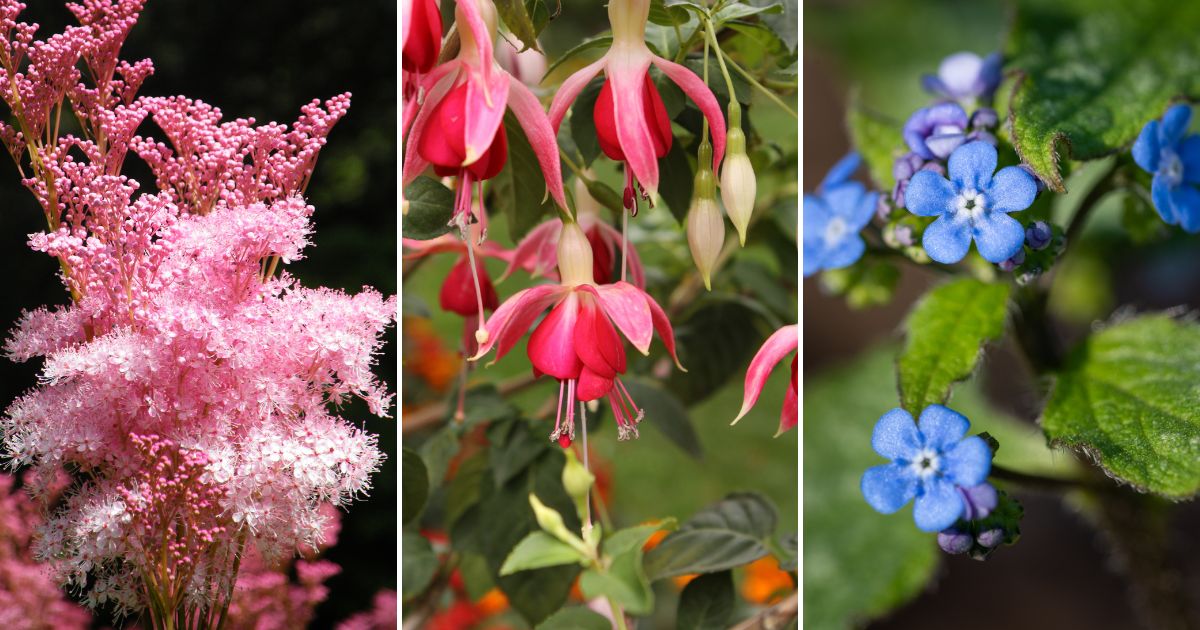Transform your garden’s shady spots into vibrant displays with these 20 stunning flowers.
Each of these plants is specially selected for their ability to thrive in low-light conditions, adding bursts of color and life where the sun rarely shines.
From elegant blooms to lush foliage, these flowers are perfect for adding beauty and charm to any shadowy corner of your garden.
1. Astilbe
Astilbe is a perennial favorite for shaded gardens, offering feathery plumes of pink, white, or red flowers that can brighten any dark corner. With its fern-like foliage and ability to thrive in moist, shady conditions, Astilbe is both beautiful and low-maintenance.
2. Hosta
Hostas are renowned for their lush, broad leaves that come in an array of greens, blues, and variegated patterns. Perfect for adding texture and depth to shady areas, these plants are as easy to care for as they are attractive.
3. Bleeding Heart
The Bleeding Heart is known for its unique, heart-shaped flowers that dangle elegantly from arching stems. This plant thrives in woodland settings, making it ideal for shaded gardens with its delicate pink or white blooms.
4. Fuchsia
Fuchsia plants are perfect for adding a splash of vivid color to shaded areas. Known for their pendulous two-tone flowers, Fuchsias are excellent for hanging baskets and containers, bringing life and movement to any space.
5. Lungwort
Lungwort might have a funny name, but its speckled leaves and charming blue or pink flowers are no joke. This plant is perfect for shady spots, thriving in cool, moist environments and adding a whimsical touch to your garden.
6. Brunnera
Brunnera, often called Siberian Bugloss, features stunning heart-shaped leaves with silvery spots and clusters of tiny blue flowers in spring. It’s a perfect choice for a shady, woodland-themed garden.
7. Toad Lily
Toad Lilies are unique for their orchid-like flowers that bloom in late summer to fall. These exotic-looking blooms are perfect for adding interest to your shady garden spots, thriving where other flowers might not.
8. Japanese Forest Grass
Japanese Forest Grass, or Hakonechloa, is ideal for adding movement and texture to shady gardens. Its graceful, arching leaves come in shades of green and gold, providing a tranquil, flowing aesthetic.
9. Coral Bells
Coral Bells, or Heuchera, are prized for their vibrant, variegated foliage and delicate bell-shaped flowers. These perennials are perfect for adding color and contrast to shady garden beds.
10. Trillium
Trillium is a woodland plant that thrives in deep shade, known for its distinctive three-petaled flowers. These elegant blooms are perfect for naturalizing shady, forest-like garden areas.
11. Hellebore
Hellebores, often called Lenten Roses, bloom in late winter to early spring, providing some of the first colors of the year in shaded gardens. Their evergreen foliage and nodding flowers make them a gardener’s favorite.
12. Foxglove
Foxgloves are dramatic biennials known for their tall flower spikes covered in tubular blooms. Perfect for adding vertical interest to shaded areas, these flowers are a favorite for cottage-style gardens.
13. Japanese Anemone
Japanese Anemones bring elegance to the garden with their tall stems and delicate white or pink flowers. Blooming in late summer to fall, they provide a needed burst of color in shadier spots.
14. Snowdrop
Snowdrops are among the earliest bloomers, bringing cheer to late winter gardens. Their nodding white flowers are perfect for naturalizing in shaded areas under trees or along woodland paths.
15. Virginia Bluebells
Virginia Bluebells are spring ephemerals that add a splash of blue to shady garden areas. These bell-shaped flowers are perfect for naturalizing in wooded areas, where they create a sea of blue in early spring.
16. Lamium
Lamium, or Dead Nettle, is a versatile ground cover with variegated leaves and small pink or white flowers. Ideal for shaded spots, it offers both beauty and weed-suppressing benefits.
17. Solomon’s Seal
Solomon’s Seal is a graceful perennial with arching stems and hanging white flowers. It thrives in shady, woodland settings and adds elegance to any garden with its structured form.
18. Ajuga
Ajuga, or Bugleweed, is a ground cover known for its colorful foliage and spikes of blue flowers. Perfect for shaded areas, it quickly covers ground and helps prevent erosion.
19. Tiarella
Tiarella, or Foamflower, is prized for its frothy blooms and unique leaf patterns. Perfect for shady gardens, it adds both texture and color throughout the growing season.
20. Epimedium
Epimedium, often called Barrenwort, thrives in dry shade and is perfect for rocky gardens. Known for its heart-shaped leaves and delicate flowers, it provides year-round interest with minimal care.




















